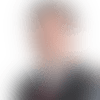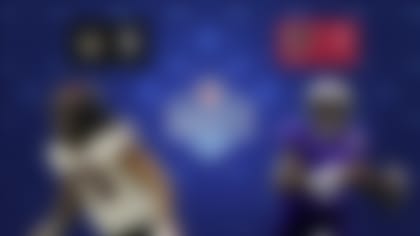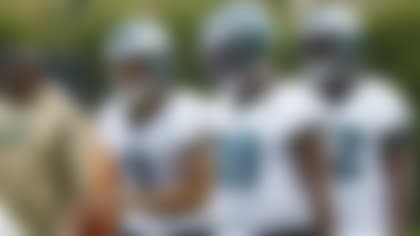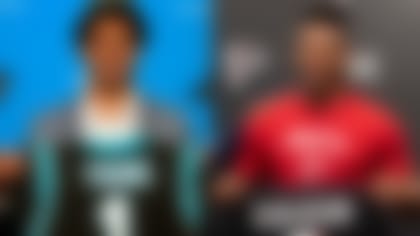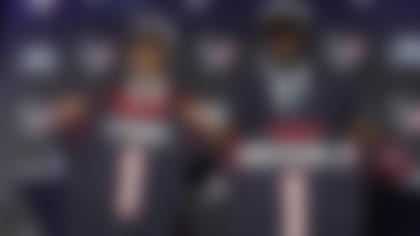Why provide instant grades on the selections of prospects who have yet to take an NFL snap? Well, you're reading this, aren't you? Considering the makeup of every roster and the factors surrounding each pick, Gennaro Filice and Dan Parr attempt a division-by-division assessment of the 2020 NFL Draft. Keep in mind that these grades are based on draft hauls alone -- picks traded for veteran players were not taken into account. Click here for those full breakdowns.
Below you'll find a ranking, from 1 to 32, of the 2020 draft classes.
» Round 1: (No. 28 overall) Patrick Queen, LB, LSU.
» Round 2: (55) J.K. Dobbins, RB, Ohio State.
» Round 3: (71) Justin Madubuike, DT, Texas A&M; (92) Devin Duvernay, WR, Texas; (98) Malik Harrison, LB, Ohio State; (106) Tyre Phillips, OG, Mississippi State.
» Round 4: (143) Ben Bredeson, OG, Michigan.
» Round 5: (170) Broderick Washington, DT, Texas Tech.
» Round 6: (201) James Proche, WR, SMU.
» Round 7: (219) Geno Stone, S, Iowa.
PARR: Baltimore somehow managed to find amazing value in almost every round. It seems unfair that they do this year after year, really. Queen fills the void that had been lingering since C.J. Mosley departed last offseason and will go sideline to sideline, wreaking havoc with his explosiveness despite being undersized. Dobbins adds another dose of electricity to the Ravens' highly charged backfield and the value was too good to pass up, even if there were more pressing needs. Oh, and you better believe Eric DeCosta did work with four third-round selections, pouncing to add -- you guessed it -- nice value in the middle portion of the draft. Harrison is a downhill attacker who will complement Queen at 'backer, and Madubuike will help keep blockers off of those two. We're intrigued by Duvernay, who could become a spark plug in the slot if he improves as a route runner. There are Hall-of-Fame worthy shoes to fill at guard following the retirement of Marshal Yanda, but Phillips and Bredeson seem like perfect fits for the Ravens' power running game. We approve of the decision to trade up in Round 6 for Proche, who has the ball skills and competitiveness to be much more productive than his athletic traits would lead you to believe. And how about landing Stone with pick 219, nearly 100 slots lower than where Jeremiah valued him? There were the only team that had his top value pick in two different rounds. Well done, Ravens.
» Round 1: (No. 17 overall) CeeDee Lamb, WR, Oklahoma.
» Round 2: (51) Trevon Diggs, CB, Alabama.
» Round 3: (82) Neville Gallimore, DT, Oklahoma.
» Round 4: (123) Reggie Robinson II, CB, Tulsa; (146) Tyler Biadasz, C, Wisconsin.
» Round 5: (179) Bradlee Anae, Edge, Utah.
» Round 7: (231) Ben DiNucci, QB, James Madison.
FILICE: What a difference drafting on a $250 million mega yacht makes! Jerry Jones spent the virtual draft aboard the Bravo Eugenia, a predictably glitzy setting for the league's ultimate showman owner. But separated from COO Stephen Jones, vice president of player personnel Will McClay and new head coach Mike McCarthy, Jerrah was flying without a parachute. Nobody was there to snatch the draft card out of the boss' hand, should he have been tempted to do something like drafting Johnny Manziel over Zack Martin. No matter. The Star King absolutely crushed this draft, logging immense value in each of his first six picks while simultaneously filling roster needs. Lamb was a gift from the Draft Gods. It's a player you just have to pick in the second half of Round 1, regardless of how your draft needs stack up. But the real brilliance of the Cowboys' draft is how they found ways to fill holes after making the quasi-luxury pick at wide receiver. Diggs was a cornerback many mocked to Dallas at No. 17 -- instead, the Cowboys landed him 34 slots later. Gallimore received some first-round buzz during the pre-draft process -- Dallas nabbed him midway through the third. And then on Day 3, the 'Boys made a number of need-based selections who could significantly outproduce their respective draft slots. Robinson's a long, strong cover man who excelled in multiple coverages at Tulsa and posted some enticing numbers in Indy. Biadasz took a step back last season at Wisconsin due to injuries, or else he would've been long gone by the time Dallas came on the clock at No. 146. Now he's tossed into the center battle with veteran Joe Looney and 2019 third-rounder Connor McGovern. If Biadasz can get right again, the Cowboys could end up replacing one Badgers pivot (the recently retired Travis Frederick) with another. And Anae enters the NFL with a pretty refined pass-rushing arsenal, which should help Dallas replace the 11.5 sacks and 13 TFLs that left with Robert Quinn in free agency.
» Round 1: (No. 22 overall) Justin Jefferson, WR, LSU; (31) Jeff Gladney, CB, TCU.
» Round 2: (58) Ezra Cleveland, OT, Boise State.
» Round 3: (89) Cameron Dantzler, CB, Mississippi State.
» Round 4: (117) D.J. Wonnum, Edge, South Carolina; (130) James Lynch, Edge, Baylor; (132) Troy Dye, LB, Oregon.
» Round 5: (169) Harrison Hand, CB, Temple; (176) K.J. Osborn, WR, Miami (Fla.).
» Round 6: (203) Blake Brandel, OG, Oregon State; (205) Josh Metellus, S, Michigan.
» Round 7: (225) Kenny Willekes, Edge, Michigan State; (244) Nate Stanley, QB, Iowa; (249) Brian Cole II, S, Mississippi State; (253) Kyle Hinton, OG, Washburn.
FILICE: Since he started running Minnesota's drafts back in 2007, Rick Spielman has impressively drafted 16 Pro Bowlers. Still, his past few prospect hauls haven't proven nearly as fruitful as the glory classes of 2015 and prior. Consequently, we've seen an uptick in heat on the GM's seat. Prior to January's Wild Card Weekend upset of the Saints, Spielman received a public vote of confidence from Vikings owner Mark Wilf. But the fact remains that the GM's contract -- like that of head coach Mike Zimmer -- is set to expire after the 2020 season. So this sure feels like a make-or-break draft class for Spielman. At this moment -- days after the picks were made and long before anyone's set to take a real, live NFL snap -- I think Rick nailed it. And not just because he made half the picks in the entire draft. (OK, 15 to be exact.) The Vikings' first three selections could very well produce three Day 1 starters. Jefferson replaces Stefon Diggs opposite Adam Thielen in the receiving corps, while Gladney and veteran CB Mike Hughes will hit the starting lineup following the departures of Xavier Rhodes and Trae Waynes. Cleveland might claim the tackle slot opposite Brian O'Neill, kicking Riley Reiff inside to guard and giving Minnesota the most athletic bookend duo in the league -- a highly enticing possibility, given how much the Vikings' outside-zone scheme relies on OL mobility. One Day 3 pick to keep an eye on is Dye. A long, athletic linebacker with legit coverage chops, the 6-foot-3 231-pounder led Oregon in tackles during each of the past four seasons. He might be limited to special teams duty in Year 1, but don't be surprised if Dye eventually joins Eric Kendricks and Anthony Barr in the starting lineup, giving the Vikes a versatile linebacking corps ideally suited to the modern game.
» Round 1: (No. 8 overall) Isaiah Simmons, LB/S, Clemson.
» Round 3: (72) Josh Jones, OT, Houston.
» Round 4: (114) Leki Fotu, DT, Utah; (131) Rashard Lawrence, DT, LSU.
» Round 6: (202) Evan Weaver, LB, Cal.
» Round 7: (222) Eno Benjamin, RB, Arizona State.
FILICE: Three years ago, Steve Keim spent his first-round pick on hybrid defender Haason Reddick. When asked how the Temple product would fit into Arizona's defense, the Cardinals general manager gushed: "That's the beauty of it -- it doesn't matter," Keim said at the time. "We'll find a place for him. Whether it's early as a rusher or as a stack-backer, he has got enough skills to be a difference maker for us, and we'll find the right place for him on our defense." Three years and 20 starts later, Reddick remains a man without a role. In fact, before the draft last week, The Athletic's Michael Lombardi said the former No. 13 overall pick's "another guy for the Cardinals that they would gladly move on from." Oof. Now Arizona faces the same kind of questions about the 6-foot-4, 238-pound freak of nature with the 4.39 40-yard dash. How will Simmons be deployed in Vance Joseph's defense? "He'll be a linebacker," the defensive coordinator said. "But we drafted this guy because of what we saw him do at Clemson. So, the things he did there, he's going to do for us also. As far as covering tight ends, and again, he's going to be a problem solver. Obviously, each game plan is different and, as problems come along and he can solve them for us he will definitely be a candidate to do those things for us." Now, it must be pointed out that, while the Reddick experiment has been a complete failure, the Cardinals do have multiple success stories on the positionless-player front. Tyrann Mathieu became a Defensive Player of the Year candidate as a roving playmaker, Deone Bucannon briefly served as the LB/S prototype and Budda Baker -- drafted 23 picks after Reddick -- continues to redefine the safety position. Here's hoping Joseph and Co. have the right plan to maximize Simmons' rare skill set. Something I'm fairly certain of: Arizona got a steal in Day 2 and Day 3. Jones, a battle-tested left tackle with NFL traits, had no business lasting until Round 3. And Benjamin, an open-field nightmare who came off the board in Round 7, could hit some home runs in the wide-open space created by Kliff Kingsbury's offense.
» Round 1: (No. 1 overall) Joe Burrow, QB, LSU.
» Round 2: (33) Tee Higgins, WR, Clemson.
» Round 3: (65) Logan Wilson, LB, Wyoming.
» Round 4: (107) Akeem Davis-Gaither, LB, Appalachian State.
» Round 5: (147) Khalid Kareem, DE, Notre Dame.
» Round 6: (180) Hakeem Adeniji, OG, Kansas.
» Round 7: (215) Markus Bailey, LB, Purdue.
PARR: Our one quibble with the Bengals' draft was the decision to wait until Round 6 to address the offensive line after not adding to it in free agency, but overall, this was nice work. Sure, the Burrow pick seems like a no-brainer, but it's still a great one that instantly rejuvenates the franchise. He's coming off the best year ever by a college quarterback. And Cincinnati was smart to add another weapon for him to kick off Round 2. Higgins could become another A.J. Green in due time, but for now, they get to team up together, creating a tandem that could do a lot of damage to defenses. Linebacker was this team's biggest need on defense, and we're fans of all three players they selected at the position, even though we would have probably turned to the offensive line over Davis-Gaither in Round 4. Wilson is a future starter, and Bailey could provide tremendous value for a seventh-round pick if he's able to stay healthy. Kareem isn't going to wow anyone with explosiveness or athleticism, but he can provide solid depth off the edge. We liked what the Bengals did when they finally selected an offensive lineman. Adeniji has a chance to develop into a starting guard and was Jeremiah's top value of Round 6.
» Round 1: (No. 9 overall) C.J. Henderson, CB, Florida; (20) K'Lavon Chaisson, Edge, LSU.
» Round 2: (42) Laviska Shenault, WR, Colorado.
» Round 3: (73) DaVon Hamilton, DT, Ohio State.
» Round 4: (116) Ben Bartch, OT, St. John's (Minn.); (137) Josiah Scott, CB, Michigan State; (140) Shaquille Quarterman, LB, Miami.
» Round 5: (157) Daniel Thomas, S, Auburn; (165) Collin Johnson, WR, Texas.
» Round 6: (189) Jake Luton, QB, Oregon State; (206) Tyler Davis, TE, Georgia Tech.
» Round 7: (223) Chris Claybrooks, CB, Memphis.
PARR: Jacksonville came into this draft in rebuilding mode and did a fine job of adding a boatload of talent while also filling most of its top needs. There was a glaring void at corner following the trades of Jalen Ramsey and A.J. Bouye, so the Henderson pick made plenty of sense -- and the same goes for the Chaisson selection, with Yannick Ngakoue wanting out of town. Landing the second-best corner and edge rusher in the draft? That'll work. Shenault's stock took a hit during the evaluation process due to durability concerns. He offers a lot of upside but a lower floor, too. If it all comes together for him, the Jaguars could come away with three first-round values from this draft. Hamilton went a little earlier than expected, but has a chance to develop into a starter, and we loved the Bartch pick. Don't sleep on the undersized Scott as a future starting nickel corner, either. We wouldn't have minded seeing the Jags gamble on a prospect with a little more upside than Quarterman late in Round 4, but he should be a decent backup at inside 'backer. GM Dave Caldwell added more depth at positions of need later on Day 3, but the main takeaway here is he ended up tying for the league-high by drafting eight players from NFL Network draft expert Daniel Jeremiah's top 150 prospects, including three of his top 36. This is good news for Duval County.
» Round 1: (No. 5 overall) Tua Tagovailoa, QB, Alabama; (No. 18) USC OT Austin Jackson; (No. 30) Auburn CB Noah Igbinoghene.
» Round 2: (39) Robert Hunt, OL, Louisiana; (56) Raekwon Davis, DT, Alabama.
» Round 3: (60) Brandon Jones, S, Texas.
» Round 4: (111) Solomon Kindley, OG, Georgia.
» Round 5: (154) Jason Strowbridge, DE, North Carolina; (164) Curtis Weaver, edge rusher, Boise State.
» Round 6: (185) Blake Ferguson, LS, LSU.
» Round 7: (246) Malcolm Perry, RB, Navy.
PARR: This was the Dolphins' draft to control. They entered it with the most picks in the league, including three first-rounders, and used the capital about as well as they could. We like the risk they were willing to take with their first selection. Tagovailoa's potential was too great to pass up, even with the injury concerns. Jackson and Igbinoghene went earlier than many expected them to, but in those two players, Miami might have a future starting left tackle and a tough, competitive, physical nickel back -- you need to be good at those spots to win in today's NFL. We're not here to strongly dock the Fins for those decisions, even if a case can be made that they were reaches. The Igbinoghene pick foreshadowed the Dolphins' theme for Day 2 of the draft, as the master plan of adding tough, physical, powerful talent was fully revealed with the selections of Hunt, Davis and Jones. Big fan of the work they did on the defensive line on Day 3, landing a Senior Bowl standout (Strowbridge) and a potential steal in Weaver, who didn't allow below-average explosiveness to keep him from racking up 34 sacks over the past three seasons. Last but not least, Perry -- he of 2,017 rushing yards last season -- has a chance to earn a spot as a versatile contributor who can help on offense and special teams. Now, the merits of drafting a long snapper might be debatable, but all in all, a really nice haul here.
» Round 1: (No. 3 overall) Jeff Okudah, CB, Ohio State.
» Round 2: (35) D'Andre Swift, RB, Georgia.
» Round 3: (67) Julian Okwara, Edge, Notre Dame; (75) Jonah Jackson, OG, Ohio State.
» Round 4: (121) Logan Stenberg, OG, Kentucky.
» Round 5: (166) Quintez Cephus, WR, Wisconsin; (172) Jason Huntley, RB, New Mexico State.
» Round 6: (197) John Penisini, DT, Utah.
» Round 7: (235) Jashon Cornell, DT, Ohio State.
FILICE: After spending months broadcasting across the universe that the Lions were open for business at No. 3, GM Bob Quinn ended up keeping the pick and taking the right player. Considering need, positional value, scheme fit and talent of the actual prospect, the Okudah selection was completely/appropriately predictable. The same cannot be said about Detroit's second-rounder. Despite the fact that the Lions haven't finished in the top half of the league in rushing offense since Barry Sanders' retirement last millennium, Detroit was rarely mentioned as a potential landing spot for Swift. Perhaps because this same Lions regime aggressively targeted Kerryon Johnson via second-round trade-up just two years ago. Or maybe it was all that presumptuous pre-draft chatter about Swift being the only first-round back in this class. Once that designation actually applied to Clyde Edwards-Helaire on draft night, though, and Swift fell into the second round, the Lions pounced. As you can surmise by the grade atop this blurb, I'm not here to lecture anyone about the folly of spending valuable draft currency on a running back. In fact, I applaud this pick. Johnson, who has a lengthy injury history going back to his Auburn days, has missed nearly half the games in his two NFL seasons. And while Bo Scarbrough was a pleasant surprise down the stretch of a lost season, let's not pretend his 4.2 yards per carry portended future stardom. With all due respect to Pro Bowl wideout Kenny Golladay, this offensive roster isn't exactly bursting at the seams with electric playmakers. Swift brings exciting juice to the run and pass games. Early in Round 3, Quinn attempted to fill a void that's marred Patricia's defense two years running: edge rush. In a draft class light on top-end sack artists, Okwara could end up as a third-round coup. Quinn and Patricia also continued their passion project of rebuilding the offensive line with a pair of mid-round guards: one who specializes in pass blocking (Jackson) and one who belligerently mauls opponents in the ground game (Stenberg).
» Round 1: (No. 10 overall) Jedrick Wills, OT, Alabama.
» Round 2: (44) Grant Delpit, S, LSU.
» Round 3: (88) Jordan Elliott, DT, Missouri; (97) Jacob Phillips, LB, LSU.
» Round 4: (115) Harrison Bryant, TE, Florida Atlantic.
» Round 5: (160) Nick Harris, C, Washington.
» Round 6: (187) Donovan Peoples-Jones, WR, Michigan.
PARR: Baker Mayfield has to be resting easier these days. GM Andrew Berry gifted him with a massive upgrade at the tackle spot, signing Jack Conklin in free agency to man the right side, and then he went out and drafted a new left tackle with the 10th overall pick. Wills was the top player at his position on many boards. He should be protecting the blindside for the next decade. The next-biggest need for this club was at safety, and Berry checked that box by plucking Delpit. Concerns about his tackling knocked him out of the first-round conversation, but there's still plenty to like about his game as a fast, instinctive free safety. We see a lot of upside in the Elliott pick. He can provide a push from the inside. We're not as enthusiastic about the Phillips selection. Linebacker was a need and Phillips led a talent-rich LSU defense in tackles last season, but he might not become more than a backup/special-teams contributor at the next level. We wouldn't have minded seeing the Browns go in a direction other than tight end to start Day 3 with Austin Hooper and David Njoku (who just had his fifth-year option picked up despite his disappointing 2019 season) already on the roster. That said, have you seen NFL.com draft analyst Lance Zierlein's comp for Bryant? It's George Kittle! So, we're not going to argue with taking a shot on that kind of player. Harris provides some depth on the interior O-line, and Peoples-Jones was worth a flyer in Round 7 even though he never lived up to his billing at Michigan.
» Round 1: (No. 14 overall) Javon Kinlaw, DT, South Carolina; (25) Brandon Aiyuk, WR, Arizona State.
» Round 5: (153) Colton McKivitz, OT, West Virginia.
» Round 6: (190) Charlie Woerner, TE, Georgia.
» Round 7: (217) Jauan Jennings, WR, Tennessee.
FILICE: Sometimes, in the wake of the three-day team-building bonanza that is the NFL draft, it's hard to wrap your head around the thinking that went into a particular franchise's overall haul. That is most definitely NOT the case with San Francisco's 2020 draft class. Every pick had a purpose. With all the money the 49ers have poured into their definitive position group -- defensive line -- DeForest Buckner unfortunately ended up being the odd man out. The Niners just couldn't pay him the money he was due, so they flipped him for a first-round pick ... and then used that pick on a younger, cheaper version of Buckner in Kinlaw. Like Buckner, Emmanuel Sanders was another talented veteran the Niners just couldn't fit into their salary cap. So they let him walk to New Orleans ... and used their second first-round pick on a prime playmaker at wideout in Aiyuk. San Francisco mitigated the retirement of franchise stalwart Joe Staley by trading for Trent Williams, but they still needed depth at the tackle position. Insert McKivitz, who has experience on the left and right side -- and could be San Francisco's swing tackle in Year 1. Meanwhile, anyone who's watched Kyle Shanahan's offense of late knows how crucial a role Kyle Juszczyk plays. Well, the versatile H-back's getting up in age and heading into the last year of his contract. Could Woerner be groomed as the eventual replacement? And lastly, Jennings is exactly the kind of YAC monster Lil Shanny loves to feature. Don't dwell on the 4.72 40 -- he has steal potential as a big-slot playmaker. Calculated drafting from stem to stern.
» Round 1: (No. 13 overall) Tristan Wirfs, OT, Iowa.
» Round 2: (45) Antoine Winfield Jr., S, Minnesota.
» Round 3: (76) Ke'Shawn Vaughn, RB, Vanderbilt.
» Round 5: (161) Tyler Johnson, WR, Minnesota.
» Round 6: (194) Khalil Davis, DT, Nebraska.
» Round 7: (241) Chapelle Russell, LB, Temple; (245) Raymond Calais, RB, Louisiana-Lafayette.
FILICE: So, what's it gonna be, Bucs fans: Tompa Bay or Tampa Brady? GM Jason Licht continues to do everything in his power to put the new franchise face in the best possible position to succeed, using three of his first four picks on offensive needs. Wirfs looks like a plug-and-play starter at right tackle, with supreme athleticism and the biggest lower body I've ever laid eyes on at the NFL Scouting Combine. (Seriously, this man is a far superior species to me.) Round 3 frankly felt a little rich for Vaughn -- RB Zack Moss' violent, all-around game seemed a lot more enticing at that point -- but the Buccaneers needed another backfield presence to join Ronald Jones II, and apparently the one-cut Vandy product was their guy. Johnson could be the final piece to Tampa's loaded pack of pass catchers, as a big slot who runs the kind of nuanced routes Brady will appreciate. The one defensive player Licht snatched in the first five rounds is a gem. A versatile safety who's perfect for today's game, Winfield hits like his dad and has the playmaking instincts you'd expect from someone who grew up in NFL locker rooms. "When I was younger my dad would lay in his bed with his laptop, and I would be sitting right next to him watching film," Winfield said at the combine. Todd Bowles is gonna have fun with this newbie.
» Round 1: (No. 4 overall) Andrew Thomas, OT, Georgia.
» Round 2: (36) Xavier McKinney, S, Alabama.
» Round 3: (99) Matt Peart, OT, Connecticut.
» Round 4: (110) Darnay Holmes, CB, UCLA.
» Round 5: (150) Shane Lemieux, C/OG, Oregon.
» Round 6: (183) Cameron Brown, LB, Penn State.
» Round 7: (218) Carter Coughlin, Edge, Minnesota; (238) T.J. Brunson, LB, South Carolina; (247) Chris Williamson, CB, Minnesota; (255) Tae Crowder, LB, Georgia.
FILICE: After beginning each of the previous two drafts with a bold pick -- Saquon Barkley at No. 2 in 2018 and Daniel Jones at No. 6 in '19 -- Dave Gettleman played it safe this time around, taking the high-floor offensive tackle who should help maximize those audacious actions of yesteryear. Thomas didn't put on the kind of attention-grabbing combine spectacle of some of the other Big Four tackles, but he was a highly decorated starter on a talented Georgia team during each of his three years in Athens. And hey: He was Pro Football Focus' top-rated offensive tackle in this class. Dave Gettleman ... analytics acolyte?! New York rightfully continued to pour resources into the offensive line with the third-round pick of Peart (a developmental tackle with promising raw traits) and the fifth-round selection of Lemieux (who could make a push to start at center in Year 1). And the Giants backed up the free-agent signing of CB James Bradberry with two more intriguing additions to the secondary. After hitting on a hybrid safety out of Alabama early in the second round five years ago (Landon Collins), the Giants went back to that same Tuscaloosa well for McKinney. And he might not be the only rookie starter in Big Blue's defensive backfield. Nickel cornerback is essentially a starting position in today's NFL, and many evaluators -- NFL Media's Bucky Brooks included -- think Holmes has the physical profile to excel in that role on Sundays.
» Round 1: (No. 11 overall) Mekhi Becton, OT, Louisville.
» Round 2: (59) Denzel Mims, WR, Baylor.
» Round 3: (68) Ashtyn Davis, S, Cal; (79) Jabari Zuniga, edge rusher, Florida.
» Round 4: (120) La'Mical Perine, RB, Florida; (125) James Morgan, QB, Florida International; (129) Cameron Clark, OG, Charlotte.
» Round 5: (158) Bryce Hall, CB, Virginia.
» Round 6: (191) Braden Mann, P, Texas A&M.
PARR: Yes, we know there's low-floor potential with Becton. We also have heard that he's a 6-foot-7, 364-pound mountain of a man who mauls people. So, Sam Darnold can rest a little easier at night (and hopefully won't have to wonder if Iowa OT Tristan Wirfs, who went a couple picks later, would have been the better pick at No. 11). Oh, and GM Joe Douglas found a good value in Round 2 even after trading down, enhancing Darnold's supporting cast again with the addition of Mims. If he can master a more complex route tree than he was asked to run at Baylor, look out. Douglas then turned to his defense, snagging one of the middle-rounders who generated the most buzz this spring. This will be a great pick if it all comes together for the freakishly athletic Davis, dubbed the draft's "mystery man" by one general manager last month. The Jets might have reached a bit to fill a need with the Zuniga pick. The production (18.5 career sacks in four seasons) doesn't jump off the page, but injuries were a bugaboo. Perhaps Gregg Williams can coax the most out of a player who certainly has shown flashes. Douglas must have enjoyed his time scouting in the Sunshine State, as he added a couple more Florida men to start Day 3. Perine, who can churn out tough yards, was a fine choice to fill a need behind Le'Veon Bell. We also weren't bothered by the decision to take a shot on the big-armed Morgan as a backup for Darnold. Same goes for how Douglas closed things out on in the draft's last few rounds, checking off needs and finding nice value once again with Hall in Round 5.
» Round 1: (No. 7 overall) Derrick Brown, DT, Auburn.
» Round 2: (38) Yetur Gross-Matos, Edge, Penn State; (64) Jeremy Chinn, S, Southern Illinois.
» Round 4: (113) Troy Pride Jr., CB, Notre Dame.
» Round 5: (152) Kenny Robinson, S, West Virginia.
» Round 6: (184) Bravvion Roy, DT, Baylor.
» Round 7: (221) Stantley Thomas-Oliver III, CB, Florida International.
FILICE: If you watched the 2020 NFL Draft for five minutes, you heard the phrase "Rhule Restoration" 10 times. So, what exactly is that, besides snappy alliteration? Well, in the first draft of the Matt Rhule era, Carolina's Rhule Restoration consisted of carpet-bombing the defense with draftees -- ALL THE DRAFTEES. The Panthers became the first team in the common-draft era to use all of their picks on defensive players. It's actually not that surprising, either. Carolina finished 31st in scoring defense last season. ... And then one of the very best players in franchise history -- linebacker Luke Kuechly -- abruptly retired. ... And then the Panthers' CB1 signed a mega-deal with the Giants. ... And then they lost four experienced disruptors up front (Mario Addison, Bruce Irvin, Dontari Poe and Vernon Butler), as well as Eric Reid in the back end. Long story short, Carolina came into this draft with serious needs on all three levels of the defense. In Round 1, the Panthers passed on do-everything playmaker Isaiah Simmons in favor of a stout anchor to build around (Brown). In Round 2, they snagged a toolsy edge rusher to hunt opposite last year's first-round pick, Brian Burns, and then traded back into the round to score Chinn, an intriguing hybrid who feels like store-brand Simmons. The most notable Day 3 addition was Pride, who could push for early playing time in a cornerback rotation currently topped by the inconsistent Donte Jackson and the awesomely named/minimally proven Corn Elder. Rhule Restorers ... MOUNT UP!
» Round 1: (No. 15 overall) Jerry Jeudy, WR, Alabama.
» Round 2: (46) KJ Hamler, WR, Penn State.
» Round 3: (77) Michael Ojemudia, CB, Iowa; (83) Lloyd Cushenberry, C, LSU; (95) McTelvin Agim, DT, Arkansas.
» Round 4: (118) Albert Okwuegbunam, TE, Missouri.
» Round 5: (178) Justin Strnad, LB, Wake Forest.
» Round 6: (181) Netane Muti, OG, Fresno State.
» Round 7: (252) Tyrie Cleveland, WR, Florida; (254) Derrek Tuszka, edge rusher, North Dakota State.
PARR: Love the way the Broncos kicked off their draft, snagging a Pro Bowl-caliber complement for Courtland Sutton and arguably the class' WR1. That was only the beginning of John Elway's tour de force when it came to adding help for one of the draft's biggest winners, Drew Lock, who made it clear he appreciated the effort by blasting out the cool sunglasses face emoji via Twitter shortly after the Broncos plucked another receiver with their second pick. Hamler can flat out fly, giving Denver the field-stretcher it needed. We would have liked to see the team draft a tackle at some point, but the squad did add help for the interior O-line. Cushenberry is a plug-and-play starter at center and Muti could prove to be a tremendous value at guard if he can stay healthy (played in just 19 games over four seasons due to injury). There's no denying there's some significant bust potential with a few members of this class, including the polarizing Okwuegbunam, which is why we tempered our enthusiasm for the group a bit. Plus, Ojemudia went surprisingly early, coming off the board at No. 77 after coming in at No. 148 on NFL Network draft guru Daniel Jeremiah's list of the draft's top 150 prospects. But there's a lot to like here.
» Round 2: (No. 34 overall) Michael Pittman, WR, USC; (41) Jonathan Taylor, RB, Wisconsin.
» Round 3: (85) Julian Blackmon, S, Utah.
» Round 4: (122) Jacob Eason, QB, Washington.
» Round 5: (149) Danny Pinter, OG, Ball State.
» Round 6: (193) Robert Windsor, DT, Penn State; (211) Isaiah Rodgers, CB, Massachusetts; (212) Dezmon Patmon, WR, Washington State; (213) Jordan Glasgow, LB, Michigan.
PARR: There was no action for Indy in Round 1 after dealing its top pick to the Niners for DeForest Buckner, but the Colts got busy on Day 2, making a couple selections that should bring smiles to the faces of Philip Rivers and his many children. Pittman might even remind Rivers of his old go-to guy with the Chargers, Vincent Jackson. The former Trojan has the size to go up and get it. Now, close your eyes for a second and imagine Taylor running behind Quenton Nelson and Co. ... Do you see a mess of defenders being pushed backward and a bruising back pummeling them? I do. Indianapolis could soon be home to the league's model power run game after Taylor, who racked up 6,000-plus rushing yards in three college seasons, joins forces with that front five. The Blackmon selection didn't have the same sizzle as Chris Ballard's first two picks. It seemed a little early for my taste, given his inconsistency in his first season after moving from corner to safety, but I can understand wanting to add depth in the secondary. Some folks were expecting Eason to go in Round 2, so we can't argue with the value in the fourth round. He gets to sit behind Rivers -- and this won't be a bad pick even if he never becomes more than a decent backup, given how late the Colts were able to get him. Glasgow has a chance to carve out a role as a special-teams ace. It would have been nice to see Indy add another young edge rusher at some point.
» Round 1: (No. 24 overall) Cesar Ruiz, C, Michigan.
» Round 3: (74) Zack Baun, LB, Wisconsin; (105) Adam Trautman, TE, Dayton.
» Round 7: (240) Tommy Stevens, QB, Mississippi State.
FILICE: Heading into the draft, New Orleans didn't have a single glaring need. With an NFL-best 37 wins over the past three regular seasons, the Saints boast as well-rounded -- and battle-tested -- a roster as there is in the NFL today. So it's no wonder they chose to package picks in multiple trade-ups, leaving the draft with the league's smallest prospect haul. How does the class grade out? Not too shabby. Spending a first-round pick on an interior offensive linemen isn't exactly sexy, but that doesn't mean it's senseless. Ruiz was the top pivot in his recruiting class out of high school, started at guard and center during three fine years of play in Ann Arbor and hits the NFL ready to start on Day 1. (Incumbent right guard Larry Warford and his hefty cap hit appear to be on borrowed time.) Baun gives New Orleans a versatile linebacker in the Kyle Van Noy mold. He can provide pressure off the edge, but also has the athleticism and awareness to hold his own in coverage. And Trautman's an intriguing developmental prospect as a true Y tight end. At 6-5 and 255 pounds, he's equal parts receiver and blocker, but his transition from the FCS to the NFL is gonna take time. Small class, big potential.
» Round 2: (No. 54 overall) A.J. Epenesa, DE, Iowa.
» Round 3: (86) Zack Moss, RB, Utah.
» Round 4: (128) Gabriel Davis, WR, UCF.
» Round 5: (167) Jake Fromm, QB, Georgia.
» Round 6: (188) Tyler Bass, K, Georgia Southern; (207) Isaiah Hodgins, WR, Oregon State.
» Round 7: (239) Dane Jackson, CB, Pittsburgh.
PARR: Brandon Beane took care of his biggest need last month, giving up a package of picks, including this year's first-rounder, for WR Stefon Diggs. However, we're grading purely on the work done on draft weekend here (their grade would be higher if the Diggs deal was being taken into account). Beane still did a good job with his remaining capital, though! He found a first-round-caliber player late in Round 2. Epenesa was once considered a likely top-15 pick, but fell out of favor with the draft cognoscenti due in part to an NFL Scouting Combine workout that didn't inspire. That said, he filled Buffalo's top need entering the draft and was one of the best values in the draft, according to NFL Network draft expert Daniel Jeremiah. We like it, and can say the same thing for the selection of Moss, a violent runner who fills the void left by Frank Gore. Now, we would have preferred to see Buffalo go with a corner with its first pick on Day 3 (Josiah Scott? Amik Robertson?) with Josh Norman in decline and playing on a one-year deal, but we understand the allure of continuing to add weaponry for Josh Allen, and the Bills did find value at the corner position with the selection of Jackson in the final round. Davis has the size and catch radius to snag Allen's throws downfield and Hodgins is another tall tree who can go up and get it. The Fromm pick was an eyebrow-raiser, but we can't argue with the value. Weird things happen on Day 3, as we were also surprised they decided to reel in Bass in Round 6, but hey, he was arguably the best kicker in the draft. Sorry, Stephen Hauschka.
» Round 1: (No. 2 overall) Chase Young, Edge, Ohio State.
» Round 3: (66) Antonio Gibson, RB/WR, Memphis.
» Round 4: (108) Saahdiq Charles, OT, LSU; (142) Antonio Gandy-Golden, WR, Liberty.
» Round 5: (156) Keith Ismael, C, San Diego State; (162) Khaleke Hudson, LB, Michigan.
» Round 7: (216) Kamren Curl, S, Arkansas; (229) James Smith-Williams, Edge, North Carolina State.
FILICE: At the end of the day, Washington made the pick everyone anticipated at the beginning of the year. Young is widely considered the top overall player in this draft class. Tossing him into a defensive front that already includes a trio of recent first-round picks (Montez Sweat, Daron Payne and Jonathan Allen), the underrated Matt Ioannidis and four-time Pro Bowler Ryan Kerrigan immediately gives Ron Rivera's Redskins an identity: QB NIGHTMARE FUEL. Bruce Allen left behind a roster that still has plenty of holes, but new defensive coordinator Jack Del Rio has a game-wrecking group to work with up front. Building strength on strength is underrated. But after the no-brainer pick at No. 2, Washington made three straight boom-or-bust selections. Gibson's a hybrid playmaker with 4.39 speed, but he only posted one year of serious production at Memphis (see: 12 touchdowns on just 71 touches). And how different is he from one of last year's pleasant surprises, Steven Sims Jr.? Are their skill sets redundant? Meanwhile, just minutes after Washington ended the Trent Williams saga by trading the disgruntled left tackle to the 49ers for a pair of mid-round picks -- man, Mr. Allen sure botched this ... -- the 'Skins drafted the left tackle from the 2019 national champion LSU Tigers. Charles is a talented prospect, no doubt, but there's a reason he was still available on Day 3. He missed six games in 2019 due to disciplinary issues and three in 2018 due to injury. Gandy-Golden's an intriguing physical specimen out wide at 6-4 and 223 pounds, but the former Liberty Flame is obviously taking a big step up in competition.
» Round 1: (No. 12 overall) Henry Ruggs III, WR, Alabama; (No. 19) Ohio State CB Damon Arnette.
» Round 3: (80) Lynn Bowden, RB, Kentucky; (81) Bryan Edwards, WR, South Carolina; (100) Tanner Muse, LB, Clemson.
» Round 4: (109) John Simpson, OG, Clemson; (139) Amik Robertson, CB, Louisiana Tech.
PARR: Ruggs might not be the prototypical WR1 with size, but we're not sure how much that matters because he's fast enough to run past just about every defender he'll encounter, and it's lazy to suggest he's simply a deep threat. We have no issue with Vegas rolling the dice on him even with Jerry Jeudy and CeeDee Lamb still on the board. Mike Mayock and Jon Gruden filled their biggest need with the pick and now Derek Carr has no excuse for failing to throw the ball downfield. And credit to the decision makers for not stopping there when it came to upgrading the QB's supporting cast. A receiver turned quarterback for Kentucky last season, Bowden will start off as a running back for the Raiders, but it's a safe bet we'll see him lining up in the slot, too. He brings the type of edge this team covets. A foot injury kept Edwards from working out at the NFL Scouting Combine, but if his hands improve, he has the size and strength to become a nice complementary piece in this recharged receiving corps. NFL.com draft analyst Lance Zierlein's player comp for him (former Bears first-round bust David Terrell) is terrifying, though. Now, Arnette at No. 19 was not as big of a reach as some are making it out to be, but it was still a little rich for my blood given that the second-best edge rusher in the draft (K'Lavon Chaisson) was still available, among other options that intrigued me more than the Ohio State corner. That said, corner was the team's biggest need other than receiver. We're very fond of the Robertson pick. The competitive streak runs strong in the undersized slot man who shouldn't be underestimated.
» Round 1: (No. 16 overall) A.J. Terrell, CB, Clemson.
» Round 2: (47) Marlon Davidson, DL, Auburn.
» Round 3: (78) Matt Hennessy, C, Temple.
» Round 4: (119) Mykal Walker, LB, Fresno State; (134) Jaylinn Hawkins, S, Cal.
» Round 7: (228) Sterling Hofrichter, P, Syracuse.
FILICE: Over the course of the pre-draft process, Jeff Okudah was widely considered the top cornerback prospect, while C.J. Henderson established himself as CB2. But the third-best corner in this class? That was a hotly debated topic. When the Falcons weighed in with their decision -- taking Terrell, an Atlanta native, at No. 16 overall -- many disapproved, including ESPN draft guru Mel Kiper Jr., who said the team "reached for a need, plain and simple." I have a sneaking suspicion there's some recency bias at play here. Terrell, after all, had a rough night at the office in his last game, the College Football Playoff National Championship. On the brightest stage of his playing career, Terrell was torched by LSU wide receiver Ja'Marr Chase. But let's be honest: Who didn't get torched by Ja'Marr Chase? The Biletnikoff Award winner caught 84 passes for 1,780 yards and 20 touchdowns -- with the latter two marks setting SEC records -- and he's poised to be a very highly selected player in the 2021 draft. Outside of that tough outing, Terrell acquitted himself pretty darn well on the island. He's long (6-1) and fast (4.42 40), too. And with everyone screaming "REACH!!" upon his selection, the 21-year-old should enter the NFL with a pretty big chip on his shoulder. Very interested to see how his career plays out.
» Round 1: (No. 29 overall) Isaiah Wilson, OT, Georgia.
» Round 2: (61) Kristian Fulton, CB, LSU.
» Round 3: (93) Darrynton Evans, RB, Appalachian State.
» Round 5: (174) Larrell Murchison, DT, North Carolina State.
» Round 7: (224) Cole McDonald, QB, Hawaii; (243) Chris Jackson, DB, Marshall.
PARR: With Jack Conklin's departure leaving a hole at right tackle, Titans GM Jon Robinson found a massive human to fill it. At 6-6, 350 pounds, Wilson can maul folks off the edge, but the technique and footwork are going to have to be more consistent for this pick to pay off. Right now, it looks like at least a slight reach. On the other hand, Fulton was a value late in Round 2. He's a nice fit who can help replace Logan Ryan. The Titans filled another need with Evans, who should be fun to watch as a speedy, one-cut runner to complement Derrick Henry's power. I'm not seeing much to be excited about on Day 3 for Tennessee. Murchison could fit into a rotation on the interior D-line and McDonald is going to have to tighten up his delivery to have any shot of making it as a backup. I was surprised Robinson didn't take an edge rusher in this draft, as I viewed it as one of the team's biggest needs.
» Round 2: (No. 52 overall) Cam Akers, RB, Florida State; (57) Van Jefferson, WR, Florida.
» Round 3: (84) Terrell Lewis, Edge, Alabama; (104) Terrell Burgess, S, Utah.
» Round 4: (136) Brycen Hopkins, TE, Purdue.
» Round 6: (199) Jordan Fuller, S, Ohio State.
» Round 7: (234) Clay Johnston, LB, Baylor; (248) Sam Sloman, K, Miami (Ohio); (250) Tremayne Anchrum, OG, Clemson.
FILICE: Draft for need or take the best player available? It's the age-old draft debate -- and one that's top o' mind with Los Angeles' draft class. For most of last season, the O-line was viewed as a chief culprit in L.A.'s offensive reversion. Consequently, after the Rams didn't bring in any new offensive linemen in free agency, you figured they'd toss some early draft capital at the problem last week. Not so much. GM Les Snead waited until his final selection -- a compensation pick at No. 250 overall -- before adding a blocker. So I guess the Rams will be running it back with the same unit Pro Football Focus ranked 31st last season. That is a failure. So why does the grade not reflect that sentiment? Well, putting the O-line issues aside for a second, the first four players Snead selected really tickled this draft grader's fancy. In a quietly loaded RB class, Akers got lost in the shuffle. The former five-star recruit routinely produced behind a porous offensive line at Florida State -- which could be good training for his pro career, if the Rams' O-line doesn't shape up quick. Jefferson's exactly the kind of polished route runner you'd expect from the son of a former NFL receiver/current NFL receivers coach. He should provide immediate returns for detail-oriented Rams coach Sean McVay. In a thin pass-rushing class, Lewis is a first-round talent who just needs his body to cooperate. And Burgess is a multi-talented defensive back who could fill a number of roles for the Rams, starting in Year 1. Long story short: Snead inexplicably ignored a major need ... but added four potential rookie difference makers elsewhere.
» Round 1: (No. 32 overall) Clyde Edwards-Helaire, RB, LSU.
» Round 2: (63) Willie Gay Jr., LB, Mississippi State.
» Round 3: (96) Lucas Niang, OT, TCU.
» Round 4: (138) L'Jarius Sneed, S, Louisiana Tech.
» Round 5: (177) Michael Danna, edge rusher, Michigan.
» Round 7: (237) Thakarius Keyes, CB, Tulane.
PARR: There might not have been a better fit in the draft than Edwards-Helaire and the Chiefs. Quibble with taking a running back in the first round if you'd like, but Andy Reid has his new Brian Westbrook (or, gulp, perhaps an even better version of the former All-Pro). CEH is the dynamo K.C. didn't technically need (yes, the offense was already great) but will certainly get the most out of. We didn't love anything else about what the Chiefs did, but that's not really surprising considering their flexibility was pretty limited, as they entered the draft tied for the fewest selections in the league (five). There's a case to be made that they should have added a true corner earlier than Round 7, but that might be where Sneed, a safety last season at Louisiana Tech, ends up playing. Gay was one of the stars of the NFL Scouting Combine, but will he be able to put it all together and challenge for a spot atop the depth chart next season? Niang is coming off November hip surgery, but he has the tools to become a starter. On the other hand, seeing Danna, who wasn't considered a lock to be drafted, go in Round 5 was a surprise. This isn't a bad haul, but the excitement about it wore off for us after Day 1, which probably means this will be a great group.
» Round 1: (No. 6 overall) Justin Herbert, QB, Oregon; (23) Kenneth Murray, LB, Oklahoma.
» Round 4: (112) Joshua Kelley, RB, UCLA.
» Round 5: (151) Joe Reed, WR, Virginia.
» Round 6: (186) Alohi Gilman, S, Notre Dame.
» Round 7: (220) K.J. Hill, WR, Ohio State.
PARR: Chargers GM Tom Telesco said this week that he would have taken whichever of the top three quarterbacks fell to him at No. 6, which is a refreshingly candid comment, albeit probably not the strong vote of confidence Justin Herbert would like to hear. Anyway, Herbert was undoubtedly picked earlier than where he was ranked on most boards, but that happens with quarterbacks all the time. If they couldn't trade down and feel confident they'd still get Herbert, they had to stick and pick. It's going to be interesting to see how much time the team gives him before he sees game action with Tyrod Taylor atop the depth chart for now, and whether Herbert becomes more comfortable with being aggressive as a passer. As for the surprising decision to trade back into Round 1, we like Murray, a three-down linebacker who will make plays all over the field. However, we're not certain that sitting out Day 2 in order to get him was the best move for a team that still has a glaring need at left tackle (a position it didn't address in this draft). L.A. found some depth/special teams help on Day 3, starting with a player who can help make up for the loss of Melvin Gordon. Kelley helped himself with his performances at the Senior Bowl and NFL Scouting Combine. Landing Hill in Round 7 has a chance to be a good value. The guy is Ohio State's all-time catch leader and was projected to go two or even three rounds earlier by some draftniks.
» Round 1: (No. 21 overall) Jalen Reagor, WR, TCU.
» Round 2: (53) Jalen Hurts, QB, Oklahoma.
» Round 3: (103) Davion Taylor, LB, Colorado.
» Round 4: (127) K'Von Wallace, S, Clemson; (145) Jack Driscoll, OT, Auburn.
» Round 5: (168) John Hightower, WR, Boise State.
» Round 6: (196) Shaun Bradley, LB, Temple; (200) Quez Watkins, WR, Southern Mississippi; (210) Prince Tega Wanogho, OL, Auburn.
» Round 7: (233) Casey Toohill, Edge, Stanford.
FILICE: While the selection of Reagor over Justin Jefferson took some by surprise, the TCU wideout is more of the deep threat Philadelphia clearly needed. Remember how quickly the air came out of this offense once DeSean Jackson went down last season? The Eagles needed another (younger) home-run hitter, and that's exactly what Reagor is. (Don't fret about the somewhat-ordinary 4.47 40-yard dash in Indy; Reagor's play speed might be up there with any prospect not named Henry Ruggs III in this class.) While Philly's decision to take Reagor over Jefferson raised a few eyebrows, the Eagles' second-round pick left mouths agape across the country. Is No. 53 overall really the place to draft a backup quarterback who needs development as a thrower? Related question: If the Eagles are so worried about Wentz's long-term availability, why'd they hand him a nine-figure extension that included a record-setting $107.9 million in guarantees less than a year ago? Yes, we know: You want to be "a quarterback factory." That's a nice thing to aspire to, but this roster sprung leaks all over the place last season. Might wanna concentrate on plugging more of those -- like linebacker, a position that's befuddled this franchise in a post-Jeremiah Trotter world. Philadelphia took a swing at LB in the third round, but Taylor's still extremely raw, as religious commitments kept him from playing football games on the Sabbath until the past few years. Let's finish on a positive note, though: Wallace looks like a potential steal at No. 127, especially for a team that needs secondary help.
» Round 2: (No. 43 overall) Cole Kmet, TE, Notre Dame; (50) Jaylon Johnson, CB, Utah.
» Round 5: (155) Trevis Gipson, Edge, Tulsa; (163) Kindle Vildor, CB, Georgia Southern; (173) Darnell Mooney, WR, Tulane.
» Round 7: (226) Arlington Hambright, OG, Colorado; (227) Lachavious Simmons, OG, Tennessee State.
FILICE: Chicago throwing a two-year, $16 million deal at over-the-hill TE Jimmy Graham was one of the bigger head-scratchers in free agency. And then Ryan Pace turned around and spent the team's top pick on Kmet, adding a 10th tight end(!) to the Bears' roster. Chicago waived Dax Raymond on Monday, bringing the TE clown car's occupancy back to single-digit passengers, but what's going on here? Are the Bears trying to exorcise the demons of the Greg Olsen trade? Publicly trolling Mike Martz? Cornering the TE market in a fantasy draft? How about using the No. 43 overall pick to address a true offensive need on the line? Seven picks later, Pace did home in on the defense's biggest void -- cornerback -- with the selection of Johnson. Given his alluring mix of physical traits, ball skills and cerebral play, the Utah corner might be a steal at No. 50 overall. Then again, Johnson was only available there because he's fresh off his third shoulder surgery. In the fifth round, Chicago took a couple swings at small-school speedsters -- a CB in Vildor (4.44 40-yard dash) and a WR in Mooney (4.38) -- and Pace has a nice track record of finding talent in the middle rounds (SEE: Eddie Jackson, Adrian Amos, Nick Kwiatkoski, Tarik Cohen and Jordan Howard). The sixth-year GM needs some hits in this draft class, or else the Halas McCaskey fam could hit the eject button.
» Round 2: (No. 40 overall) Ross Blacklock, DT, TCU.
» Round 3: (90) Jonathan Greenard, Edge, Florida.
» Round 4: (126) Charlie Heck, OT, North Carolina; (141) John Reid, CB, Penn State.
» Round 5: (171) Isaiah Coulter, WR, Rhode Island.
PARR: The stench of some of Bill O'Brien's trades wafts over this draft class, but it's a solid, albeit unspectacular, group. Blacklock was a fine value in Round 2. He should eventually be able to help the pass rush from the interior, but he's going to have to be more consistent against the run -- a key factor for a guy who will be lining up across from the power running games of Jacksonville, Indianapolis and Tennessee. Houston came back for the edge help it needed with the selection of Greenard, who went a little earlier than we expected. Heck should be a serviceable swing tackle, at worst. Reid's another guy who came off the board sooner than we anticipated, but his competitiveness gives him a chance to make up for what he lacks in size. The best pick from this group might turn out to be Coulter, a developmental prospect with the tools to become a starter. All in all, needs were addressed, even though we might quibble with the order in which they received attention. This was a decent haul given the limited value the Texans had in draft capital.
» Round 1: (No. 27 overall) Jordyn Brooks, LB, Texas Tech.
» Round 2: (48) Darrell Taylor, Edge, Tennessee.
» Round 3: (69) Damien Lewis, OG, LSU.
» Round 4: (133) Colby Parkinson, TE, Stanford; (144) DeeJay Dallas, RB, Miami (Fla.).
» Round 5: (148) Alton Robinson, Edge, Syracuse.
» Round 6: (214) Freddie Swain, WR, Florida.
» Round 7: (251) Stephen Sullivan, TE, LSU.
FILICE: One thing's for sure: The Seahawks draft to the beat of their own drum. Brooks had his fans in league circles. Directly following the pick, virtual draft maestro Trey Wingo observed, "Well, this is interesting, because I had one coach tell me this week, 'I wish people would stop putting Jordyn Brooks in their mock draft -- we love this kid, we don't want everybody to know him." The tackling machine's Texas Tech tape is indeed fun. Yet still: The notion of spending a first-round pick on a downhill thumper -- without established coverage skills -- seems like a questionable use of draft resources in 2020. Especially when off-ball linebacker wasn't an immediate need for this annually contending team. On Day 2, Pete Carroll and John Schneider looked to infuse both lines with some much-needed talent. Taylor brings the length and strength Seattle desires off the edges. The only problem is he remains unrefined as a playmaker/finisher despite five years of service in the SEC. Lewis is an absolute road-grader in the ground game at 327 pounds. The only problem is he remains somewhat of a liability in pass pro, which isn't ideal for the preservation of franchise superman Russell Wilson.
» Round 2: (No. 49 overall) Chase Claypool, WR, Notre Dame.
» Round 3: (102) Alex Highsmith, edge rusher, Charlotte.
» Round 4: (124) Anthony McFarland, RB, Maryland; (135) Kevin Dotson, OG, Louisiana.
» Round 6: (198) Antoine Brooks Jr., S, Maryland.
» Round 7: (232) Carlos Davis, DT, Nebraska.
PARR: Before you tweet something derogatory about us, Steelers fans, just know that the grade would be higher if we were taking into account the Minkah Fitzpatrick trade and move up to snag Devin Bush last year, which cost them valuable capital in this year's draft. We're sticking exclusively to grading 2020 draft hauls in this exercise, folks. The good news is that even with limited flexibility, the Steelers were still able to pick up some intriguing talent. The class is just a little short on juice, and they didn't address a significant need on the defensive line until the final round. Pittsburgh added a massive target for Ben Roethlisberger in Claypool, although he doesn't offer much sizzle after the catch. Highsmith is a nice sleeper pick. He will get at least a year to add some needed size and strength behind T.J. Watt and Bud Dupree, who is playing on the franchise tag in 2020. McFarland's flashes have been something to behold -- he shredded Indiana and Ohio State for 200-plus yards rushing in consecutive games in 2018. If he can stay healthy and figure out how to flash on a more consistent basis, this will be an excellent selection, but it was a little bit surprising to see them gamble on him within the first 125 picks. Dotson was the first player picked who wasn't invited to the NFL Scouting Combine. Flip on the tape and you'll see a blocker with the power to make his way into a starting lineup down the road. Brooks can be an immediate help on special teams.
» Round 2: (No. 37 overall) Kyle Dugger, S, Lenoir-Rhyne; (60) Josh Uche, LB, Michigan.
» Round 3: (87) Anfernee Jennings, edge rusher, Alabama; (91) Devin Asiasi, TE, UCLA; (101) Dalton Keene, TE, Virginia Tech.
» Round 5: (159) Justin Rohrwasser, K, Marshall.
» Round 6: (182) Mike Onwenu, OG, Michigan; (195) Justin Herron, OL, Wake Forest; (204) Cassh Maluia, LB, Wyoming.
» Round 7: (230) Dustin Woodard, C, Memphis.
PARR: No one's earned the right to be confident more than Bill Belichick, but this Patriots draft felt sort of ... well, arrogant. They didn't bother to address needs at quarterback or wide receiver and took a kicker when it was still early in the fifth round, making Rohrwasser the first specialist selected in 2020. Belichick has said the decision to pass on drafting a QB 10 times "wasn't by design," so that sounds like he didn't hate the talent at the position in this draft. He just didn't feel compelled to take one in a year where he's riding with Jarrett Stidham and Brian Hoyer. Alrighty then. The Pats did address several voids with their selections after trading out of Round 1 and picking up an extra pick, though. Dugger provides some much-needed youth at safety and while he comes from a small school, he looked like a guy who belonged when he faced all-star competition at the Senior Bowl. Uche, another Senior Bowl standout, appears to be a good fit with raw athletic tools that Belichick can mold. Jennings drew a comp to former Patriot Kyle Van Noy from colleague/draft guru Lance Zierlein, so it would seem he landed in the right place. New England had to add at tight end, and finally did in Round 3, trading up for both Asiasi and Keene, which were somewhat surprising decisions given that there were arguably better prospects at the position available at both spots. The decision to add depth to the O-line later on Day 3 made sense. Overall, there were things to like and things to question in this class.
» Round 1: (No. 26 overall) Jordan Love, QB, Utah State.
» Round 2: (62) AJ Dillon, RB, Boston College.
» Round 3: (94) Josiah Deguara, TE, Cincinnati.
» Round 5: (175) Kamal Martin, LB, Minnesota.
» Round 6: (192) Jon Runyan, OG, Michigan; (208) Jake Hanson, C, Oregon; (209) Simon Stepaniak, OG, Indiana.
» Round 7: (236) Vernon Scott, DB, TCU; (242) Jonathan Garvin, Edge, Miami (Fla.).
FILICE: Palace intrigue in Titletown!
By now, you've heard all the juicy anecdotes surrounding Green Bay's stunning, STOP-THE-PRESSES selection of Love. But let's quickly review, because the drama here runs thick:
-- On draft day, Aaron Rodgers shared his Round 1 wishes with former punter/current sports talker Pat McAfee: "We haven't picked a skill player in the first round in 15 years, so that would be kind of cool." The Packers responded by ... trading up to draft his eventual replacement.
-- Of Rodgers' 364 career touchdown passes, exactly one has landed in the hands of a first-round pick. (A 1-yard toss this past December to Marcedes Lewis, a former first-round pick of the Jacksonville Jaguars.)
-- Supreme Packers scribe Bob McGinn offered his thoughts on the sitch in a piece on The Athletic after the draft: Public niceties aside, my sense is (head coach Matt) LaFleur, fresh from a terrific 13-3 baptismal season, simply had enough of Rodgers' act and wanted to change the narrative. With a first-round talent on the roster, the Packers would gain leverage with their imperial quarterback and his passive-aggressive style.
-- Supreme Packers icon Brett Favre offered his thoughts on the sitch in an appearance on the Rich Eisen Show after a conversation with Rodgers: "Tom Brady, and myself, Joe Montana and Peyton Manning, just to name a few, finished their career elsewhere. ... I think you're going to see that trend more and more, and I think Aaron will finish somewhere else.
Well alright! Now, to Rodgers' credit, Love said the two-time league MVP reached out to him on Friday to offer congratulations. Good on Rodgers. But you have to imagine he's absolutely livid right now -- and it's hard to blame him. The Pack spent their second-round pick on a hulking power back and their third-rounder on an H-back, while failing to snag a single receiver in a draft class that's purportedly historically deep at the position. Is Green Bay becoming ... a run-first operation? When you add everything up, it's impossible not to be utterly obsessed with the ...
Palace intrigue in Titletown!
Follow Gennaro Filice on Twitter @GennaroFilice.
Follow Dan Parr on Twitter _@TheDanParr_.
